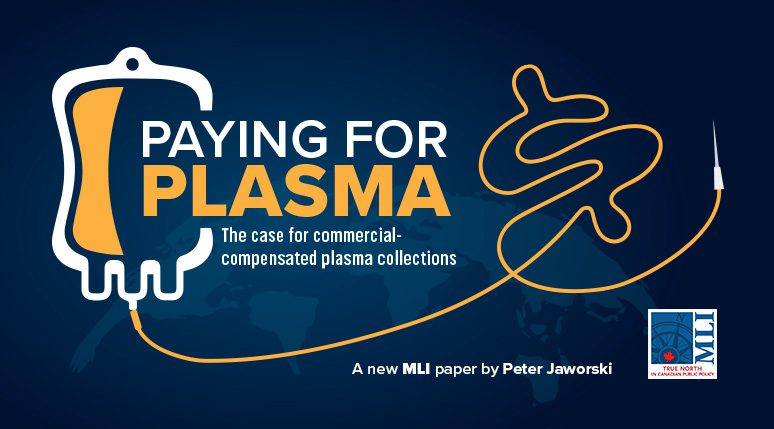OTTAWA, ON (June 13, 2023): Blood plasma is made up of a variety of essential proteins that helps our blood clot, helps us fight infections, among many other things. A sufficient supply of plasma ensures that patients have reliable access to therapies that save and improve their lives. Nonetheless for more than a decade, Canada has suffered from a growing plasma collection deficit. We are not collecting enough plasma for the patients whose lives depend upon it.
In this new MLI paper, Paying for plasma: the case for commercial-compensated plasma collections, Prof. Peter Jaworski compares a variety of plasma collection models including Canada’s to other models used around the world and examines the policies that have an impact on these models.
According to Jaworski, countries that have adopted policies legally enshrining a non-commercial, non-compensated model all suffer from plasma collection deficits. This includes countries like the United Kingdom, New Zealand, Australia, and our most populous provinces of Ontario, Quebec, and British Columbia. However, a handful of countries – Germany, Austria, Hungary, the Czech Republic, and the United States – have at least a decade’s worth of experience with policies that permit both non-commercial and commercial models to operate within their borders.
“The most important bottom-line results are these,” writes Jaworski. “Every country that permits the commercial model to operate within its borders has surplus plasma collections… Every country that prohibits the commercial model or donor compensation has plasma collection deficits.”
“These countries do not collect enough plasma to meet the therapeutic needs of their patient communities, and so to meet their patients’ needs they rely on imports of therapies made from plasma collected using commercial, compensated plasma collections… There are no exceptions.”
The most cited concern over adopting a commercial model is one of “encroachment,” or what is sometimes called “crowding out”: the worry is that compensated plasma collections, used to manufacture therapies, may adversely affect non-commercial, non-compensated blood collections used for transfusions. But Jaworski argues that there are no field studies to support this claim in any of the countries that permit a parallel commercial, compensated plasma collection system, and the evidence that we do have from Canada, the U.S. and the Czech Republic all suggests little to no negative effect.
Some maintain that a commercial model would threaten altruism and community solidarity, but Jaworski argues that what truly threatens altruism and community solidarity is our decades-long reliance on American plasma, and enduring unnecessary but foreseeable shortages of the lifesaving medicine that patients need.
“The point of a plasma collection system is not to give donors an opportunity to express their altruism or to promote community solidarity. The point of a plasma collection system is to collect enough plasma to ensure that every patient who needs plasma therapy has access to it,” writes Jaworski.
“With the facts as they are, it is time to steer away from the iceberg and to create a policy framework that permits rather than forbids commercial compensated plasma collections.”
To learn more, read the full paper here:
***
Peter Jaworski is an Associate Teaching Professor of Strategy, Ethics, Economics, and Public Policy at Georgetown University’s McDonough School of Business, and an adjunct professor of law at the University of Virginia’s School of Law. He teaches Ethical Values of Business to undergraduates and Ethical Leadership to MBAs, Executive MBAs, and Master’s in Management students.
For further information, media are invited to contact:
Skander Belouizdad
Communications Officer
613-482-8327 x111
skander.belouizdad@macdonaldlaurier.ca







